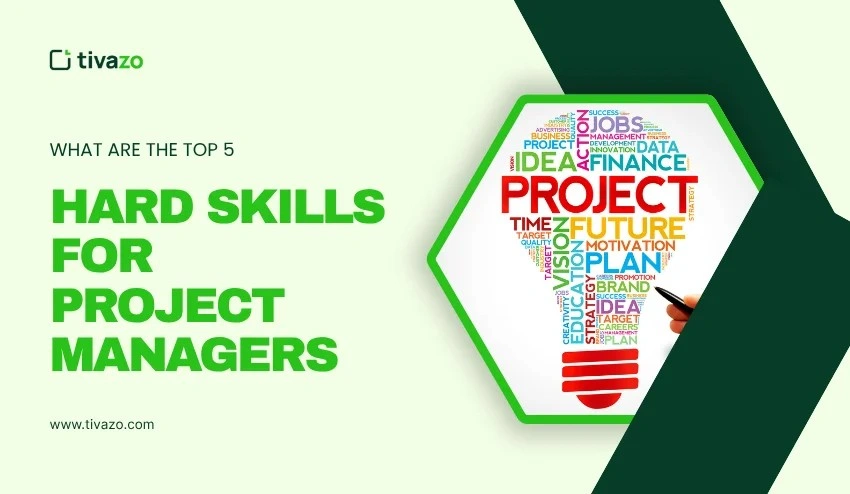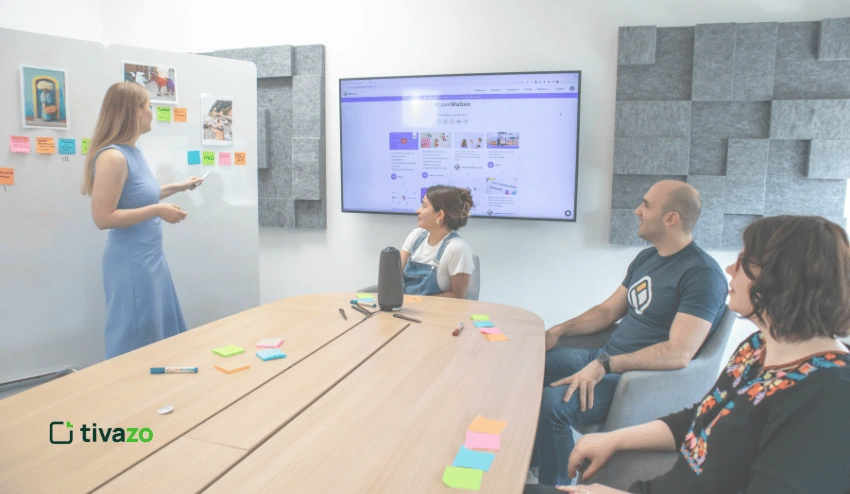Your eye bags are heavy, and lights for the new day´s start are beaming through your window. You promise yourself that you will go for a run before work. Your alarm is buzzing at 6 a.m. Outside, it is freaking freezing. But inside… oh, it is warm and cozy. In that moment, you have a decision to make: You can get up and run, or you can hit snooze and sleep for another hour.
If you are like most people, you will probably choose the second option. Why? Because sleep feels like instant comfort, the future benefits of running are just that future. This is Present Bias; humans are more likely to choose a smaller, near-term reward over a larger, distant reward.
This article will explain what present bias is, why it exists, and how you can overcome it with evidence-based strategies.
Key Highlights:
- What Is Present Bias
- Why Do We Fall Into Present Bias
- Real-Life Examples of Present Bias
- Strategies to Overcome Present Bias
- Tools to Beat Present Bias
- Present Bias in different fields
What Is Present Bias?
Present bias is a cognitive bias in which people place disproportionate value on rewards that distract from interim gratification and not on rewards that can only happen in the future.
In behavioral economics, this is closely related to hyperbolic discounting, which is when people discount the value of future rewards in an unreasonable manner in regard to immediate reward value.
Example:
- $50 today vs. $100 a month from now → most people take $50 today
- Watching Netflix tonight vs. finishing a report that can advance your career → most people choose Netflix.
Psychologists like Daniel Kahneman and Richard Thaler have documented how present bias explains procrastination, overspending, and lack of planning for the future. It’s not “laziness,” it’s hardwired in our brains.
Why Do We Fall Into Present Bias?
Present bias is not a flaw; it is evolved and inherent.
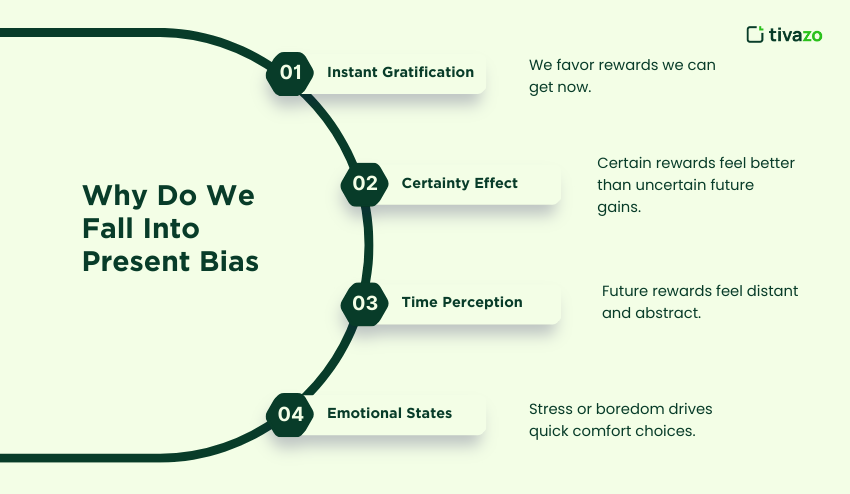
1. The Science of Instant Gratification
Our ancestors lived in real-time situations, where there was less certainty about the conditions of any moment. Therefore, if they found berries, it may have made sense to eat them immediately that day; tomorrow may not exist. That propensity to “grab what you can now” served early humans.
2. The Certainty Effect
Humans are risk-averse; we prefer a smaller guaranteed reward “right now” over a larger uncertain reward that may materialize at a later date. Consider saving for retirement.
A contribution of $500 today appears to be a loss with an uncertain 30-year payoff. By comparison, buying an electronic device online gives you ownership rights away, instant happiness at a 100% certain payoff. Certainty tricks our brains into placing much more value on the present.
3. Non-Linear Time Perception
Our brains do not process all points in time as “equal.” The reward, all its vividness, emotion, and reality, is all based on when it will be paid. A reward 30 days from now is an abstract concept.
For example: Would you like $20 today or $25 in two weeks? Most people answer with $20 today, because the prospect of waiting two weeks feels like forever. Time becomes “warped” relative to the potential reward when it is a future reward, thus making it difficult to delay gratification.
4. Emotional States
Both emotional states contribute significantly to our decision-making and instances of present bias. Stressed out, our rushed brain often compels us to opt for the fastest way to comfort. Fast food delivery, impulse buys on Amazon, or other online shopping may seem satisfying to the brain when faced with expensive project work to tackle. Similarly, boredom provokes looking at TikTok or Instagram instead of trying to do anything harder than using our phone while we are aimlessly selecting our feed time-action decision – getting instant gratification from reading a ridiculous story/blog
In fact, Present Bias is our brain’s attempt to have relief and certainty right now, even if it undermines our interests later.
What Are Real-Life Examples of Present Bias?
Present bias is not only a theoretical notion of behavioral economics it is also a way of thinking that has real-world implications and many everyday decisions we all make. Here are some examples:
1. Money: Many people swipe their credit cards for instant gratification, knowing this creates long-term credit card debt. The novelty of getting to buy something today often outweighs the abstract long-term success of a positive retirement saving outcome 20 or more years down the road.
2. Health: A classic example of present bias is food choice. A fast food option feels more convenient and tasty right now, while the distant value of healthier eating, more energy, better health, and greater longevity remains challenging to “feel” in the moment.
3. Work: At work, present bias often manifests as procrastination. A little checking of social media or chatting with a colleague gives a quick shot of pleasure, while completing a project or task takes effort in the moment, generates no immediate pleasure, and simply offers benefits later.
4. Sleep: Many of us tell ourselves, “just one more episode,” or “five more minutes on YouTube,” even when we know we will regret it during the next day’s productivity. The immediate pleasure of staying up late is far greater than the future benefit of waking up rested.
5. Relationships: Present bias is present in relationships, too. Rather than having a tough but necessary conversation, people choose to avoid a difficult conversation for the sake of short-term comfort, often damaging the long-term trust or connection. Comfort, but this often damages trust or connection in the long run.
Table of Examples:
| Situation | Immediate Reward | Long-Term Cost |
|---|---|---|
| Using credit cards | Shopping joy now | Debt later |
| Junk food binge | Pleasure now | Poor health later |
| Procrastinating | Relaxation now | Missed deadlines |
| Smoking/drinking | Stress relief now | Health risks later |
| Skipping exercise | Comfort now | Weak fitness later |
Present Self vs. Future Self
One way to conceptualize present bias is by considering yourself as two different people:
- Present Self: Wants comfort, ease, and instant gratification. This version of you values what feels good in the moment (scrolling social media, binge-watching shows, eight cups of coffee, skipping a workout) over what is good for you long term.
- Future Self: Wants long-term success, health, and happiness; it is this version of you that has an interest in the benefits of your decision today (saving money, eating healthy, accomplishing important work tasks).
The present self will be making most of the decisions in your day to day life, while your future self is merely the beneficiary of the decision you made (or did not make). This disconnect is what leads to procrastination, overspending, and the short-sighted decisions that can make us feel good today but can lead to pain down the road.
What Is the Impact of Present Bias on Goals?
Present bias sabotages long-term goals in three major ways:
- Procrastination
You procrastinate on difficult but necessary tasks that are important. Procrastination occurs if the immediate gratification of procrastinating is more appealing than the added stress and reduced results of getting something done last minute.
Example: Students put off studying until the night before exams, even though starting earlier would reduce stress and improve results. - Impulsiveness
You just decide without the ability to think it through for long-term consequences, and you abandon every decision to immediate-term desires. desires.
Example: Making a splashy holiday purchase rather than putting aside for it aside can be giving in to a whim at the moment, but in the long term it can cost you from your financial objectives. - Regret
These daily life choices made over time accumulate into stress, deprivation, and disappointment.
Example: revisiting neglected health habits or career development decisions commonly results in feelings of frustration and “what if?”
Unchecked, present bias can be a silent thief of opportunity, quietly molding choices that will compromise your future self.
How to Overcome Present Bias (5 Proven Strategies)
Now the real question: how to overcome it? Here are five evidence-based approaches.
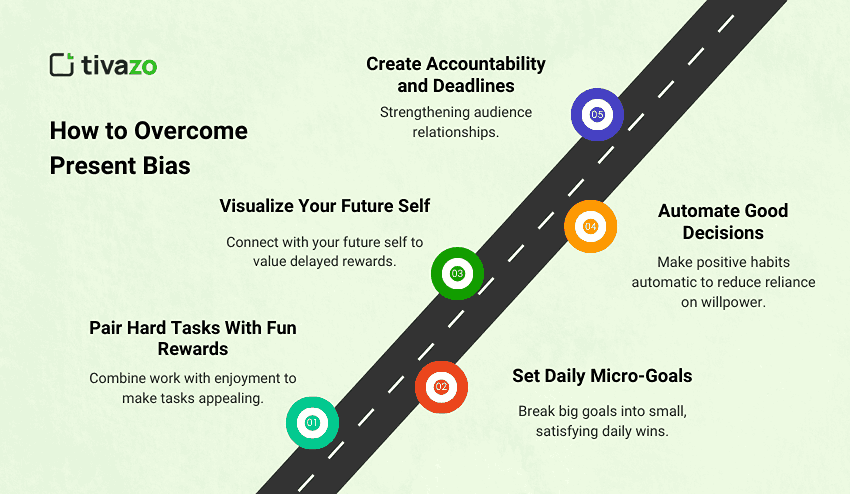
1. Pair Hard Tasks With Fun Rewards
It’s helpful to create opportunities to combine what you need to do with some type of enjoyment. This practice is called temptation bundling, and it helps to make dreaded tasks feel a little more attractive.
- Exercise: You can listen to your favorite playlist, audiobook, or podcast, but you can only do so when you’re exercising. Now, exercise is more than a task: it is entertainment.
- Work/Study: You can have a cup of your favorite coffee or snack only when you work on deep, meaningful projects.
By connecting something you enjoy with something you have to do, you begin to associate work with immediate reward, which can help you work through discomfort and, over time, build work habits.
2. Set Daily Micro-Goals
It’s easy to get lost in larger goals, which can increase the likelihood of procrastination. When you can break a goal down into smaller tasks, it can feel satisfying and less daunting.
- Writing a book: Instead of being overwhelmed with writing 300 pages, you could commit to writing 500 words a day.
- Fitness: In trying to completely overhaul your body in a week, you could commit to doing twenty push-ups or going for a ten-minute walk every day.
Each small victory elevates positive feelings in the present, which supports your motivation and declines slowly over time, and ultimately leads to spectacular outcomes.
3. Visualize Your Future Self
One of the best ways to hack present bias is to make contact with your future self. When you can see the person you will become, you are likely to make choices that are going to be positive for that person.
- Journaling: You can journal letters to your future self about your hopes, dreams, and the future you are working towards creating.
- Apps: There are digital tools that can help you contact you at a future time, which allows you to email yourself messages in the future to create a concrete connection to your future goals.
- Visual Aids: AI-driven models of your older self create an emotional connection to the future of delayed rewards, and demonstrate the urgency of saving, exercise, or career planning.
When the future seems real, there is a neurological shift in your ability to value what is delayed. In other words, you may have impulse control issues that would encourage you to abandon your delayed reward.
4. Automate Good Decisions
One of the simplest ways you can mitigate present bias is to completely remove the need for willpower. Automation ensures that good habits persist despite low motivation.
- Finance: Set automatic transfers to a savings or retirement account so you never have to *choose* to save.
- Health: Meal-prep for the week. This can help to make maintaining good eating habits easy.
- Productivity: You can utilize website blockers like Freedom or RescueTime to remove distractions while working or studying.
By intentionally making the productive choice the default, you will make it less likely that you succumb to present bias.
5. Create Accountability and Deadlines
There is no replacement for external accountability. External accountability gives a layer of immediate consequence to your actions, pushing you more toward long-term goals.
- Public Commitment: Tell your friends, family, or social media intentions for accountability! The fear of letting others down can be a motivating factor to take action.
- Accountability Groups: Whether it be a study group, a workout buddy, or a mastermind group, find an accountability group to help create consistency with your progress.
- Apps with Stakes: Tools like Beeminder literally fine you if you fail to accomplish or meet your different goals, so instant stakes are immediately worth it!
Deadlines and accountability transform abstract or long-term goals into concrete and short-term commitments, allowing you to push back against the temptation of immediate rewards.
Tools to Beat Present Bias
Technology can help translate good intent into behavior and make long-term goals more reachable.
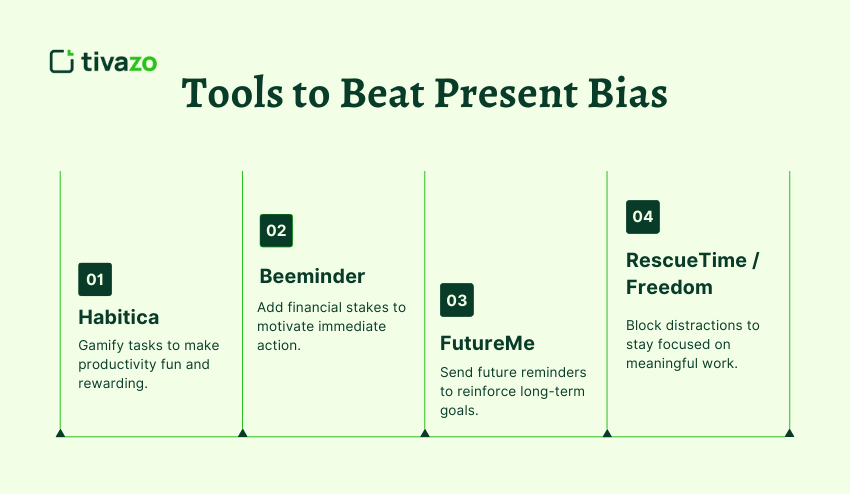
1. Habitica: A task and goal gamifier. Your tasks can be work, workouts, habits, etc. You earn pts & rewards for completing each task, thereby making productivity fun and motivating.
2. Beeminder: Puts financial stakes into your goals. You pick a target, and if you fail to hit it, pay a penalty. Your present self is thankfully encouraged to act today by this immediate consequence.
3. FutureMe: Sends you emails to make you future you. Reading reminders or motivation emails months later can, at a minimum, reinforce your connection with goals in the long run.
4. RescueTime / Freedom: Block distracting websites or keep track of your time. By removing temptation altogether, you make it easier for yourself to stick to the meaningful tasks.
Present Bias in Health and Wellness
Most people know how to be healthy. Eat well, get enough sleep, and exercise. Present bias gets in the way.
- Cake now vs. fitness later.
- Netflix now vs. sleep later.
- Skipping the gym vs. long-term energy.
Pro Tip: Try “temptation bundling” – pairing your workouts with your favourite shows or audiobooks to generate instant rewards along the way.
Present Bias in Career and Productivity
Delaying desired work tasks at the office is classic present bias. An urgent distraction like an email or message from Slack is immediately rewarding & feels better than completing a long-term project.
Solution:
- Time-block important tasks.
- Use a Pomodoro timer to add urgency
- Reward yourself as soon as you complete important milestones
Present Bias in Relationships and Lifestyle
Even in personal life, present bias gets in the way:.
- When going out to be fun instead of having an honest talk with your partner.
- Watching TV instead of calling family.
- Traveling instead of experiencing something meaningful.
Present bias leads us to seek comfort in relationships at the expense of a more authentic connection.
Conclusion
Present bias is human, but it does not have to rule your life. If you learn what your triggers are, connect with your Future Self, break up your goals, automate good habits, and stay accountable to yourself, you can make the better choice today in order to create the best future for yourself. Compound interest surely exists with human actions too. Those actions – small and consistent – over time allow you to make sacrifices today and rewards tomorrow. The more you practice resisting and delaying gratification for your goals, to live deliberately, the easier it will get.
💡 Remember: All decisions, big and small, shape your future so START DECIDING NOW!

